Life Under The Taliban A Tale of Two Eras
August 16, 2023
August marks two years since the Taliban took over Afghanistan. But this is not the only time they have held power in the war-torn country. During the first period of Taliban rule from 1996 to 2001, the people of Afghanistan suffered extensive hardships, many of which are repeating today. VOA has conducted an in-depth analysis comparing life under the earlier Taliban government with the current one across five categories: Diplomacy and Recognition, Violence and Terrorism, Media and Religious Freedom, Economy and Foreign Aid, and Women’s Rights.
Part 1 Diplomacy & Recognition
The Taliban’s capture of Kabul in 2021 marks the second time the extremist group has held power in Afghanistan. They first ruled the country from 1996 to 2001. Yet then and now, the Islamic Emirate of Afghanistan, as the Taliban call their government, has struggled to gain diplomatic recognition from the international community.
Then
After having established their base of operations in Kandahar, the Taliban first captured Kabul in September 1996. But they never managed to take over the entire country.
The northeastern regions remained under the control of a coalition of anti-Taliban fighters. This government, officially known as the Islamic State of Afghanistan, would retain official recognition by the United Nations and most member states until the Taliban was toppled in 2001.
There were exceptions. The first Taliban government, led by Mullah Omar, was officially recognized by Pakistan, whose intelligence services had been one of the group’s main sponsors, as well as the United Arab Emirates, which later withdrew its recognition following the September 11, 2001, attacks on the United States. Saudi Arabia had also granted recognition but withdrew its diplomats and suspended relations in 1998 due to Omar’s refusal to expel Osama bin Laden, by then an avowed enemy of the Saudi monarchy.
For their own part, the Taliban recognized the secessionist Chechen Republic of Ichkeria, which returned the favor before its rebellion was crushed by Russia.
Meanwhile, neighboring Turkmenistan provided unofficial support to the Taliban and helped coordinate humanitarian aid. Taliban leadership generally refused to meet with non-Muslim foreign representatives. Chinese ambassador to Pakistan Lu Shulin became the first to do so in November 2000.
Now
In many ways, the Taliban’s return to power was more successful, having captured almost all of the 34 provinces before moving into Kabul largely unopposed in August 2021.
In many ways, the Taliban’s return to power was more successful, having captured almost all of the 34 provinces before moving into Kabul largely unopposed in August 2021.
The anti-Taliban National Resistance Front, or NRF, was able to hold out in Panjshir for another month before the Taliban captured the northeastern province in September 2021. Although former Vice President Amrullah Saleh declared himself interim president, he was forced to flee to Tajikistan shortly after. The NRF and several other groups claim to maintain an armed resistance, but so far have not managed to form a unified front or attract substantial foreign support.
Russia and Iran supported the Taliban for years before the Taliban’s takeover, but their relations with the new government have since soured. As of August 2023, no country has yet formally recognized the Islamic Emirate.
But many countries have unofficially established diplomatic relations by turning over embassies and consulates to Taliban authorities and accrediting Taliban-appointed diplomats. In May 2023, Taliban spokesman Zabiullah Mujahid reported that Afghanistan had sent diplomats to at least 14 countries.
While the Taliban still have not gained official recognition after two years in power, most of the world’s governments have taken a pragmatic approach of engaging with them as the country’s de facto government. How this diplomacy proceeds will depend on many factors, including whether the Taliban move forward on their promises regarding human rights and the formation of an inclusive government.
Part 2 Violence & Terrorism
In both 1996 and 2021, the Taliban took control of Afghanistan through violent insurgencies in which thousands were killed and many more were displaced. They have been responsible for multiple war crimes and violations of human rights, while their relationships with Islamic terrorist groups have remained a major international concern.
Then
The first Taliban regime came to power in the wake of nearly 20 years of conflict, defeating a coalition of Islamic militant groups that had in turn ousted the country’s Soviet-backed government. During their campaign, the Taliban committed attacks on civilians and executed prisoners. In 1995, at least 57 were killed, as the militants shelled Kabul’s residential areas while besieging the city.
Following their takeover of Kabul in September 1996, the Taliban continued trying to conquer the northern territories, carrying out multiple massacres in areas they captured. Hundreds of civilians were killed in Bamyan and Yakaolang, while Istalif and other towns were destroyed. In Mazar-i-Sharif, Afghanistan’s fourth-largest city, the Taliban summarily executed as many as 4,000 civilians, most belonging to the Shia Hazara minority. Among those killed were 10 Iranian diplomats and a journalist. Iran threatened military retaliation.
The attacks of September 11, 2001, which killed over 3,000 people and were orchestrated by Osama bin Laden from Afghan territory, elicited a NATO-led military intervention that forced the Taliban to retreat from all major cities.
During their four-year rule, the Taliban allied with terrorist groups such as al-Qaida and the Islamic Movement of Uzbekistan, allowing them to use Afghan territory as a base of operations. In return, the terror groups contributed fighters and assassinated Taliban opponents such as military commander Ahmad Shah Massoud. But these associations earned the enmity of neighboring countries and would ultimately lead to the Taliban’s downfall. The attacks of September 11, 2001, which killed over 3,000 people and were orchestrated by Osama bin Laden from Afghan territory, elicited a NATO-led military intervention that forced the Taliban to retreat from all major cities.
Following their ouster, the United States designated the Taliban as a Specially Designated Global Terrorist and placed sanctions on individual leaders. But the U.S. did not add the group itself to the official list of Foreign Terrorist Organizations.
Now
Over the course of their 20-year insurgency, the Taliban and other anti-government elements were responsible for most civilian casualties in the country via bombings and suicide attacks. In the first half of 2021, they killed nearly 700 civilians as they began their ultimately successful offensive to retake the country.
In addition to looting and destroying homes in captured territory, the Taliban have executed surrendering soldiers, as well those suspected of working with the previous government. Despite a public offer of amnesty for former officials and police, over 100 were killed or disappeared in the early months of Taliban rule. The ethnic Shia Hazaras have once again been targeted — nine men from the Malistan district were tortured and killed in July 2021. Taliban forces have also been involved in border clashes with neighboring Iran, Turkmenistan, and even Pakistan.
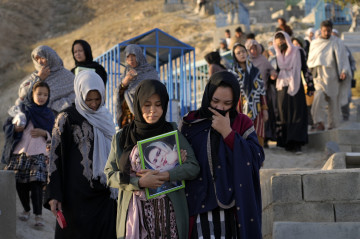
The family of 20-year-old Vahida Heydari, who was a victim of a suicide bombing on a Hazara education center, goes to her grave for a mourning ceremony, in Kabul, Afghanistan, Sunday, Oct. 2, 2022. Last week’s suicide bombing at the Kabul education center killed as many as 52 people, more than double the death toll acknowledged by Taliban officials, according to a tally compiled by The Associated Press on Monday. (AP Photo/Ebrahim Noroozi)
The Taliban have been designated as a terrorist group by Canada, Japan, Kazakhstan, Kyrgyzstan, Russia, Tajikistan and the United Arab Emirates. As part of a 2020 deal with the Trump administration, the group pledged not to harbor terrorist groups on their territory. However in July 2022, al-Qaida leader Ayman al-Zawahiri was killed in a U.S. drone strike after being discovered living in Kabul, raising questions about the Taliban’s adherence to the agreement. Taliban officials maintain they were unaware of al-Zawahiri's presence. China has also expressed concern at the presence of Uyghur fighters among other Islamist groups operating in Afghanistan.
At the same time, the Taliban have conducted operations against the local branch of Islamic State — the Islamic State of Khorasan — who they consider a rival.
Part 3 Media & Religious Freedom
The Taliban follow a strict interpretation of Islam that prohibits many forms of media and art, including music and photography. But the extent of these restrictions has changed significantly over time, reflecting broader changes in the world and in Afghan society.
Then
Even before the Taliban, years of authoritarian rule had left Afghanistan with only state-run radio and television, with little tradition of press freedom. This situation only deteriorated during the civil war, in which a great deal of infrastructure was destroyed and talent fled the country. After gaining power, the Taliban banned all forms of media except for radio, which was renamed Radio Shariat and was used to broadcast religious announcements and government orders.
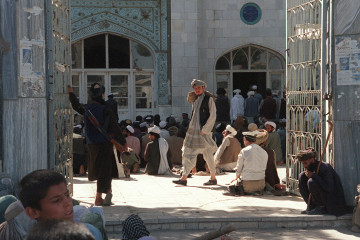
An armed soldier (L) of religious Taliban militia stands guard at the Pul-i-Khishti mosque during the Friday prayer on October 04, 1996. Taliban forced residents of the Afghan capital into mosques for prayers to mark the Moslem holy day a week after seizing power in Kabul. The Taliban warriors, who are believed to have emerged from religious seminaries, or madressas, in Pakistan, took to the Afghan scene in 1994, captured Kabul in 1996 and control two-thirds of Afghanistan, which has been at war for 20 years following the Soviet invasion of 1978. Under the Taliban, men are banned from trimming their beards and women are required to wear the all-covering tent-like burqa garment. (Photo by SAEED KHAN / AFP FILES / AFP)
Music was strictly forbidden. Musical instruments were smashed, while audio and video cassettes were confiscated, with the tape strung up on fences. Some of the national radio station’s recordings were destroyed, but the bulk of the archives were secretly preserved by station staff. The Taliban also smashed television broadcast equipment and even television sets in private homes, although one TV station still operated from territory outside of the Taliban’s control.
Internet use was also officially banned, though access was already virtually nonexistent in the war-torn nation. As per the Taliban’s fundamentalist doctrine, visual representations of humans or animals were forbidden, and the dozen or so remaining newspapers contained no photographs. Taliban leadership rarely made media appearances and did not hold press conferences or issue policy statements.
The first Taliban government was also known for its religious intolerance and persecution of minorities. Besides mass killings targeting the Shia Hazara population, the Taliban prohibited non-Muslims from sharing housing with Muslims or building new places of worship, while requiring them to wear identification badges in public. In an act that shocked the world, the Taliban also demolished two massive Buddha statues built in the sixth century, drawing condemnation even from allies such as Pakistan.
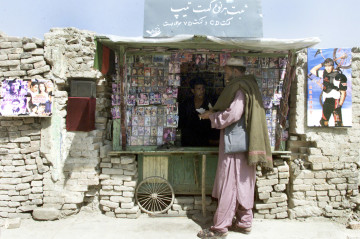
An Afghan man buys music CDs in the Afghan capital Kabul September 11, 2003. Two years after the September 11 attacks on the United States, Afghans are enjoying new freedoms after the fall of the Taliban regime, but continue to face poverty and diseases. REUTERS/Ahmad Masood AM/FA
Now
Before the Taliban’s return to power in August 2021, Afghanistan had developed a vibrant media landscape, with over 600 outlets operating throughout the country. With television now much more widespread than in the 1990s, Taliban officials have so far allowed stations to operate, and have even given regular TV interviews.
But music and entertainment programs have been banned, along with foreign films or any content the Taliban deem critical of Islam , while news coverage faces heavy censorship when covering protests or security issues. Although the Taliban claim that no journalists have been killed in the country since they have been in control, the Afghanistan Journalists Center documented over 130 cases of reporters facing arbitrary detention and violence in the first year of Taliban rule.
According to Reporters Without Borders, nearly half of the country’s media outlets shut down in the early months of Taliban rule, with over 50% of male journalists and 80% of female journalists losing their jobs.
The most difficult obstacles are faced by female journalists, who are now required to cover their faces when appearing on camera. All of these restrictions have made it difficult for the media to operate. According to Reporters Without Borders, nearly half of the country’s media outlets shut down in the early months of Taliban rule, with over 50% of male journalists and 80% of female journalists losing their jobs . Afghanistan has since dropped 30 points in the World Press Freedom index, from a ranking of 122 out of 180 in 2021 to 152 in 2023.
During their 20-year insurgency, the Taliban embraced the internet and became adept at using social media for propaganda. In contrast to the austere media bans of the 1990s, the 2021 offensive was accompanied by tweets, selfies and livestreams. The group even sought to improve and expand Afghanistan’s internet connectivity, while still maintaining control through targeted shutdowns.
The previous Afghan constitution, which allowed for freedom of the press and freedom of religion, was abolished by the Taliban. While many of the country’s minority populations fled in the wake of their advance, there have since been attempts by Taliban leadership to ensure their security. Nevertheless, some communities such as the Shia Hazara have suffered ethnic violence, while Ahmadi, Baha’i and Christian converts face persecution as apostates from Islam. Proselytization is strictly forbidden for all non-Muslims.
Part 4 Economy & Foreign Aid
Despite a wealth of natural resources and a strategic location among major trade routes, Afghanistan has long been one of the world’s poorest nations, and the only one in its region to appear on the United Nations’ list of least developed countries.
Over two-thirds of the population work in agriculture, mainly as subsistence farmers, making them particularly vulnerable to the severe droughts that have periodically affected the region. Decades of conflict have devastated the country’s infrastructure, while corrupt and unstable governance has discouraged investment, leaving much of the population dependent on foreign aid.
Then
The first Taliban regime inherited a crippled economy. The state-owned industry of the prior communist government had been dependent on aid from the Soviet Union, whose collapse in 1991 left the country without support. During the ensuing civil war, GDP declined by as much as 25% annually, down to $3.1 billion in 1996.
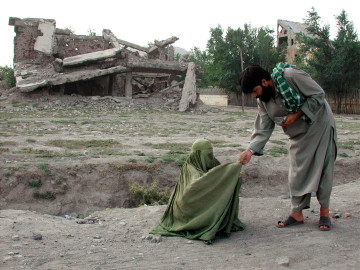
An Afghan man gives money to a woman beggar in the capital, Kabul on August 4, 2001. Begging has become rampant among Afghans, in a once proud nation which has seen nothing but war for more than two decades.
When the Taliban took power, Afghanistan had one of the world’s highest infant mortality rates at 101 deaths per 1,000 live births, and nearly one out of every six children died before their fifth birthday. Under the Taliban, there was virtually no economic growth. U.N. sanctions imposed in 1999 for the Taliban’s refusal to turn over Osama bin Laden, combined with one of the worst droughts in the country’s history, exacerbated the economic situation and created a humanitarian crisis.
International aid organizations found it difficult to operate in the country due to widespread violence and the Taliban’s restrictive regulations. Afghanistan received less than $200 million in annual aid during most of their rule. The U.N. also accused the Taliban of blocking the delivery of food aid to minority-populated regions and areas outside its control.
Opium production had long been a major source of illicit revenue, with over 90% of the world's heroin originating in Afghanistan.
Opium production had long been a major source of illicit revenue, with over 90% of the world’s heroin originating in Afghanistan. In 1999 alone, 4,600 metric tons of opium were produced, valued at $251 million or nearly one-tenth of the national GDP. Although the Taliban banned opium cultivation in 2000, the resulting surge in prices benefited Taliban leaders and allies who continued to be involved in the trade.
Now
Economic growth resumed after the Taliban’s fall in 2001, as did foreign aid. Over the 20 years prior to the Taliban’s 2021 offensive, Afghanistan had received over $77 billion in economic assistance, and its GDP had grown to over $20 billion. Health care and living standards had also improved, and the infant mortality rate declined to less than 50 per 1,000 births.
But government corruption, political instability and continued violent insurgency ensured that Afghanistan remained one of the world’s poorest countries. The 2021 offensive had immediate economic consequences, as GDP contracted by over 20%. About $7 billion of the country’s foreign reserves were frozen due to sanctions, and foreign aid — responsible for 43% of the country’s GDP and 75% of its public spending — was reduced by $2 billion.
The consequences of the Taliban takeover, as well as the recent impacts of COVID-19 and a severe drought, have combined to create what the U.N. has called the world's largest humanitarian crisis.
The consequences of the Taliban takeover, as well as the recent impacts of COVID-19 and a severe drought, have combined to create what the U.N. has called the world’s largest humanitarian crisis. As a result, the number of Afghans needing humanitarian assistance has grown from 18.4 million in 2021 to 28.3 million, or over two-thirds of the population in 2023, while child malnutrition has nearly doubled to 3.88 million.
Meanwhile, the Taliban’s repression has again impeded humanitarian aid delivery, with organizations such as Save the Children and the U.N.’s World Food Program suspending operations due to restrictions placed on female employees.
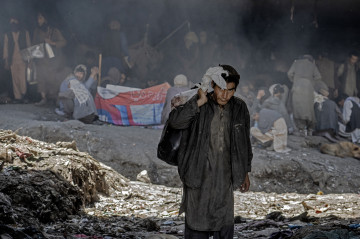
Hundreds of Afghans addicts gather under a bridge to consume drugs, mostly heroin and methamphetamines in the city of Kabul, Afghanistan,Wednesday, June 15, 2022. Drug addiction has long been a problem in Afghanistan, the world’s biggest producer of opium and heroin. The ranks of the addicted have been fueled by persistent poverty and by decades of war that left few families unscarred. (AP Photo/Ebrahim Noroozi)
Opium production was used to fund the Taliban insurgency and has boomed amid the recent chaos, with a bumper crop of 5,600 metric tons harvested and sold at a record $1.4 billion in 2022. While the Taliban have officially renewed their ban on opium cultivation, trafficking continues, and leaders acknowledge a need for international assistance to replace the lucrative source of income for farmers.
Of the $3.23 billion appealed for by the U.N. Office for the Coordination of Humanitarian Affairs in 2023, only $800 million has been raised as of August. The world’s governments, including the United States, continue to seek ways of delivering aid to the Afghan people without funding or legitimizing the Taliban. Some sanctions have been relaxed, and half of the funds frozen by the U.S. have been released for disbursement. But human rights organizations have called for deeper cooperation to address the urgent humanitarian situation.
The status of women has long been a difficult issue in Afghanistan, influenced by fundamentalist Islamic teachings as well as patriarchal local tribal traditions. The 20th century saw a succession of central governments in Kabul enact modern reforms that struggled to reach the provinces and were often reversed by subsequent regimes — a pattern that continues today.
Then
Afghan women gained universal suffrage and equality under the constitution of 1964. This unprecedented freedom continued under President Mohammad Daoud Khan and the subsequent communist government. By the 1970s, there were over 400,000 women and girls in schools across the country, and over half of university students were women. But women remained constrained by local tradition in Afghanistan’s provinces, and rural opposition to what was seen as western decadence would provide a base of support for Islamist insurgencies.
During the civil war following the fall of the communist regime, some mujahedeen groups attacked women’s rights, and women were targeted for kidnapping and sexual violence by rival factions. The reversal of gender equality accelerated with the capture of Kabul by the Taliban, who instituted the Ministry for the Propagation of Virtue and the Prevention of Vice to oversee the process.
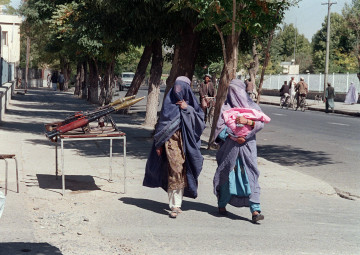
Two Afghan women dressed in the full traditional veiled called the "burka" pass by the weapons of Taliban militia in Kabul near the defence ministry, 28 September 1996. The women have to dress according to the ruling Taliban in Kabul, this is typical style of dress required by the Islamic militia. (Photo by SAEED KHAN / AFP)
Women were required to wear burkas, known by Afghans as a chadari, a full-flowing outer garment covering head to foot with a net mesh over the eyes. Apart from widows, women were not allowed to work or leave their homes without a male relative. Girls over age 8 were barred from school, though organizations like the Golden Needle Sewing School secretly met in private homes.
As a large portion of doctors and teachers were women, the sudden working ban drastically affected the health and education of the entire population. An intervention from the Red Cross led the Taliban to allow some female medical students to resume their studies. International aid organizations also found their work hampered, as they could no longer employ women.
The Taliban presented many of their restrictions as a temporary wartime measure, but promises that women would eventually be allowed to work and study in accordance with Shariah law never materialized. And despite their claims of protecting women, some Taliban commanders, along with their al-Qaida allies, were involved in the abduction and sex trafficking of hundreds of young girls.
-
1990s
- Back in the 1990s, in the areas under the Taliban's control, Hijab was made compulsory for women.
-
1990s
- Women were supposed to wear chadari, a full-flowing outer garment covering head to foot, with a net mesh over the eyes.
-
1990s
- The Taliban barred women from leaving their homes without being accompanied by a close male relative.
-
1990s
- Girls and women were not allowed to go to school or university.
-
1990s
- Women were no longer able to work. When the Taliban reached Kabul, women were worried about their jobs as most of the educated women in the country lived in Kabul.
-
1990s
- Hours after their entry into Kabul, the Taliban announced on Radio Kabul that 'All sisters who have outside work should stay at home till further notice.'
-
1990s
- The Taliban always said that once the fighting ends, women would be able to get an education and work, 'according to the Sharia law,' but nothing changed during their first rule.
Now
Prior to the Taliban takeover, women accounted for about 3.5 million students in primary schools — 33% of the 450,000 students in higher education, 30% of civil servants, 28% of parliamentarians, 21% of civil servants and 6,300 members of the 300,000-strong Afghan National Defense and Security Forces.
Upon seizing power in August 2021, the Taliban initially indicated that they would take a more moderate approach and respect the rights of women. Since then, they have introduced a series of restrictions that have gradually eroded two decades of women's progress.
Upon seizing power in August 2021, the Taliban initially indicated that they would take a more moderate approach and respect the rights of women. Since then, they have introduced a series of restrictions that have gradually eroded two decades of women’s progress. Initially, the Taliban announced that women could study in segregated classrooms. But as schools reopened in September 2021, girls were prohibited from attending beyond the sixth grade. The Ministry for the Propagation of Virtue and Prevention of Vice was reinstated, replacing the Ministry of Women’s Affairs.
In December 2021, women were prohibited from traveling more than 45 miles without a male guardian, and drivers were forbidden to accept female passengers who were not wearing a hijab. More restrictions followed in 2022. Women were first segregated and then fully banned from parks and other public spaces. Television presenters were once again ordered to cover their faces on air, and the ban on women in universities was made official.
International and domestic nongovernmental organizations have also faced difficulties, with some choosing to suspend operations rather than comply with bans on their female staff.
The Taliban’s latest measure has been a July 2023 order to close beauty salons, one of the last places where Afghan women could socialize outside the home.
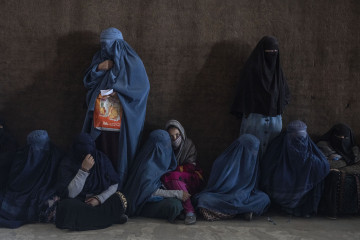
'Afghan women wait to receive cash at a money distribution organized by the World Food Program in Kabul, Afghanistan, on Saturday, Nov. 20, 2021. (AP)'
Despite promises to form an inclusive government, the Taliban’s announced interim Cabinet was exclusively composed of men, while women and journalists who protested were beaten. Twenty-eight women who previously served as MPs have fled the country, but continue to advocate internationally against Taliban policies. Meanwhile, the Taliban have violently suppressed multiple women’s protests. The U.N. special rapporteur has stated that the Taliban’s treatment of women may be considered a crime against humanity.
Taliban Orders and Announcements Affecting Women
After seizing power in August 2021, the Taliban once again imposed repressive restrictions on women in Afghanistan; however, this time the restrictions were imposed gradually.
The return of the Taliban to power erased the two decades of women’s rights gains in Afghanistan. Before the Taliban’s takeover:
- Around 3.5 million girls were going to schools
- About 33% of the 450,000 students enrolled at institutions of higher education were women.
- About 30% of the civil servants were women
- Around 28% of parliamentarians were women
- About 21% of the civil servants were women
- 6,300 women served in the security forces of about 300,000-strong Afghan national defense and security forces (ANDSF)
-
August 2021
- Women were ordered to stay home, until further notice, because Taliban fighters were not trained to respect women.
-
August 2021
- Co-education was banned and men teachers were prohibited from teaching girls.
-
September 2021
- Girls were banned from secondary education
-
September 2021
- Replaced Ministry of Women's Affairs with Ministry of Propagation of Virtue and Prevention of Vice.
-
December 2021
- Imposed a ban on women from traveling long-distance (45 miles) without a mahram.
-
December 2021
- Ordered drivers not to have women passengers without hijab.
-
February 2022
- Universities were ordered to have gender-segregated classes.
-
April 2022
- Taliban announced different days for men and women to visit parks.
-
April 2022
- Taliban announced different week days for male and female students at universities.
-
May 2022
- Taliban ordered women TV presenters to cover their face on air.
-
November 2022
- Taliban banned women and girls from parks and gyms.
-
November 2022
- The U.N. stated that the Taliban's draconian measures against women 'may amount to crime against humanity.'
-
December 2022
- Taliban banned women from university education.
-
December 2022
- Taliban ordered international and national NGOs to suspend local female staff.
-
July 2023
- Taliban ordered women's beauty salons to close in a month
Resources:
- United States Institue of Peace, The Taliban Continue to Tighten Their Grip on Afghan Women and Girls
- UNESCO, The right to education: What's at stake in Afghanistan?
- Brookings, The fate of women's rights in Afghanistan
Conclusion
Early hopes that the new generation of Taliban would be more moderate than their predecessors have steadily eroded as the militants have consolidated their power and introduced more repressive measures into Afghans’ lives. It remains to be seen whether the Taliban’s grip on power in Afghanistan will continue. But for now, the international community finds itself at an impasse where helping the people of Afghanistan may require coordination with the very regime that is largely responsible for their plight.
Credits
Writer/Producer: Alex Gendler, Roshan Noorzai
Script Editors: Megan Duzor, Sharon Shahid
Illustrations and Graphics: Sashko Danylenko, Walid Haddad, Mark Sandeen
Executive Producer: Yass Monem
Data Analysis: Ryan Damron
Special Thanks: Ayesha Tanzeem, John Featherly, Hasib Danish Alikozai
Web Design and Development: Stephen Mekosh, Dino Beslagic